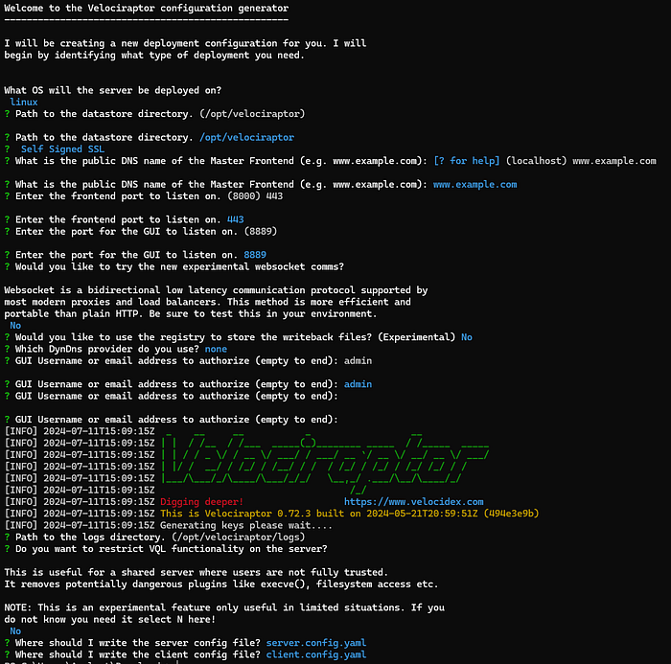Using DigiCert as the certificate Authority

Introduction
Velociraptor is a robust open-source tool designed for endpoint monitoring and digital forensics and response. Whether you deploy it on-premise or in the cloud, securing communication between the Velociraptor server and its clients is crucial. This blog post will guide you through creating and installing TLS certificates using DigiCert as your Certificate Authority (CA).
This guide has been written to provide additional guidance to the following official Velociraptor articles.
How do I use my own SSL certificates? :: Velociraptor — Digging deeper!
Velociraptor Security Configuration :: Velociraptor — Digging deeper!
Prerequisites
Before getting started, ensure you have the following:
- Domain name: Own or control a domain name, such as example.com.
- Accessible Velociraptor server: Ensure your server is accessible via a domain name, e.g., DNS A record points to your Velociraptor server’s Public IP.
- DigiCert account: A valid SSL certificate from DigiCert for your domain.
- OpenSSL: Installed on your machine.
Creating the certificate files
You will need three key files for the Velociraptor server:
- Velociraptor.pem: Contains the public certificate identifying your Velociraptor server.
- your_domain_name.key: Contains the private key for your SSL certificate. Keep this file secure.
- CA_chain.pem: Contains the certificate chain of your enterprise CA, including intermediate and root certificates.
DigiCert will provide the following files:
- Private Key:
your_domain_name.key - Primary Certificate:
your_domain_name.crt - Intermediate Certificate:
DigiCertCA.crt - Root Certificate:
TrustedRoot.crt
For details on how to request your certificates How do I Order a TLS/SSL Certificate? | DigiCert FAQ
Creating Velociraptor.pem
To create the Velociraptor.pem file, you need to convert the Primary Certificate (your_domain_name.crt) file from CRT to PEM format.
Open a terminal and run the following command:
openssl x509 -in your_domain_name.crt -out velociraptor.pem -outform PEM
Verify the certificate details:
openssl x509 -in velociraptor.pem -text -noout
You should see the details of your certificate, such as the issuer, the subject, the validity period, and the public key.
Verifying your_domain_key.key
Ensure the private key (your_domain_name.key) is in PEM format and decrypted. When viewed, the file should look like this:
-----BEGIN RSA PRIVATE KEY-----
{base64 encoded data}
-----END RSA PRIVATE KEY-----
To verify that the key format is valid, run the following command:
openssl rsa -in your_domain_name.key -check
You should see “RSA key ok”.
Creating CA_chain.pem
To create the CA_chain.pem file, you need to combine the intermediate certificate (DigiCertCA.crt) and the root certificate (TrustedRoot.crt) into one file. This can be done by simply concatenating the two files using a text editor or a command line tool. For example, you can run the following command:
cat DigiCertCA.crt TrustedRoot.crt > CA_chain.pem
Note: Ensure the order is correct: server certificate first, followed by intermediate certificates (you may have more than one), and finally the root certificate.
You should now have the following files in your cert folder:
- Velociraptor.pem (contains only the server certificate)
- your_domain_name.key (contains the unencrypted private key)
- CA_chain.pem (contains the certificate chain of your enterprise CA)
Configuring Velociraptor
To enable TLS encryption for the Velociraptor server and client:
Generate a Self-Signed SSL Configuration:
./velociraptor-0.72.3-linux-amd64 config generate -i
Note: The version number may be different for the most recent release.

Note: In this configuration I set frontend to communicate over port 443 as most firewalls in a network will allow this traffic outbound making it easier for the deployment of clients.
Update the Server Configuration:
To use your own Certificates, you need to update the server configuration file (server.config.yaml)
- Locate the frontend section and add the tls_certificate_filename and tls_private_key_filename parameters (these are not included by default).
- Enter the absolute path to these files. For testing, we placed them in /etc, but you may want to use a different location for production use.
Frontend:
tls_certificate_filename: /etc/velociraptor.pem
tls_private_key_filename: /etc/your_domain_key.key

Update the client configuration:
Note: if you have already exported a client.config.yaml, then you need to update the client section in both server.config.yaml configuration file and the client.config.yaml configuration file. Remember, the client configuration is embedded into the server configuration file, so you need to update it there as well.
1. In the client section, modify use_self_signed_ssl to be false. This will tell the client to use the CA certificate instead of the server certificate for verification.
2. Copy and paste the CA root and intermediate certificates (created in the CA_chain.pem file) to the root_certs parameter. This will allow the client to trust the CA certificate chain. For example:
use_self_signed_ssl: false
Crypto:
root_certs: |
-----BEGIN CERTIFICATE-----
The Intermediate Certificate
-----END CERTIFICATE-----
-----BEGIN CERTIFICATE-----
The Root Certificate
-----END CERTIFICATE-----
Note: As discussed in the certificate section, ensure that the intermediate and root certificates are in the correct order. The server certificate should come first, followed by any intermediate certs, and finally the root trusted authority certificate (if self-signed) for more information, please see https://www.rfc-editor.org/rfc/rfc4346#section-7.4.2
Testing the TLS Encryption
To verify the TLS encryption:
- GUI: Launch the Velociraptor server and connect to the GUI using your web browser. You should be able to access the GUI using the new certificate. You may need to trust the certificate in your browser or system to prevent errors.
- Frontend: Launch the Velociraptor client and check the logs for any errors. The client should connect securely to the server using the trusted CA chain and the new server certificate.
- No changes need to be made to the pinned certificate name, nor do any certificates need to be modified in the configuration files.
Troubleshooting
Connection/certificate errors:
To validate that the certificates you are using are in the right format, you can use the command to diagnose issues:
openssl [x509|rsa] -in CERT_FILE -text -noout
If the certificates are in the right format and valid you should use curl to confirm connectivity by requesting the server.pem file from the velociraptor server (as detailed in Troubleshooting and Debugging :: Velociraptor — Digging deeper!).
Use curl from the server localhost
curl https://localhost/server.pem -vvv
Reason: This command tests the server’s ability to serve the certificate file (server.pem) over HTTPS from the local machine. Using the -vvv flag enables verbose output, providing detailed information about the connection process, including SSL/TLS handshake details. It helps to confirm that:
- Local Server Configuration: The server is properly configured to handle HTTPS requests.
- Certificate Availability: The certificate file is accessible and correctly served by the server.
Use curl from the server localhost allowing self-signed certificates
curl https://localhost/server.pem -vvv -k
Reason: This command includes the -k option, which allows connections to servers using self-signed certificates. It helps to:
- Bypass SSL Verification: Ensure that the server can still serve the certificate even when SSL verification is bypassed. This is useful for testing purposes when using self-signed certificates.
- Debugging: Identify issues related to SSL verification failures that might not be apparent when SSL verification is enforced.
Use curl from the localhost via DNS
curl https://www.example.com/server.pem -vvv
Reason: Running this command from the localhost but using the domain name tests:
- DNS Resolution: Ensure that the domain name resolves correctly to the local server.
- SSL/TLS Configuration: Confirm that the server is correctly serving the certificate over the domain name.
Use curl from a remote client
curl https://www.example.com/server.pem -vvv
Reason: This command tests the following from a remote client (a different machine than the server):
- External Connectivity: Ensure that the server is accessible over the internet or network and that there are no firewall or network issues preventing access.
- SSL/TLS Configuration: Confirm that the SSL/TLS setup is correct and the server is properly serving the certificate to external clients.
- Certificate Acceptance: Verify that the client can accept and validate the certificate, ensuring the trust chain is correctly established.
These steps validate the entire communication path, from local server configuration to remote client connectivity.
Proxy Errors:
A proxy or SSL inspection device is a network device that inspects and modifies the traffic between the client and the server. Sometimes these devices can cause problems, especially if they are not configured properly or are incompatible with the server’s TLS version or cipher suite.
One possible error is this Server reports:
“http: TLS handshake error from XX.XX.XX.XX: :22439 read tcp XX.XX.XX.XX:443-> XX.XX.XX.XX:22439: read: connection reset by peer
This means the server-client TLS connection was interrupted. This could be due to network issues, firewall settings, or expired certificates.
Another possible error reported by the client:
“wsarecv: An existing connection was forcibly closed by the remote host.”
This means the server or something in between closed the connection abruptly. This could be due to server overload, crash, or shutdown, or a proxy or SSL inspection device that interferes with the connection.
To check if there is a proxy or SSL inspection device that is causing the connection errors, run this command:
curl https[://]server.com/server.pem -vvv
This command tries to download the server’s certificate file using curl. If the command succeeds, there is no proxy or SSL inspection device that is blocking or altering the connection. If the command fails or idles, there is something in between that is preventing or delaying the connection.
If you suspect that there is a proxy or SSL inspection device that is causing the connection errors, try these solutions:
- Review the configurations of the proxy or SSL inspection device and make sure they are compatible with the server’s TLS version and cipher suite. You can use tools like SSL Labs or TestSSL to check the server’s TLS configuration and compare it with the proxy or SSL inspection device.
- Disable or bypass the proxy or SSL inspection device temporarily and see if the connection errors go away. This can help you isolate the problem and confirm that the proxy or SSL inspection device is the culprit.
- Contact the administrator or vendor of the proxy or SSL inspection device and ask for help or guidance on how to resolve the issue. They might have some tips or updates that can fix the problem.
For full details on troubleshooting or for any other debugging issues, please see Troubleshooting and Debugging :: Velociraptor — Digging deeper!
Find out more about our Incident Response services
Interested in improving your incident response capabilities? Reach out to learn how our expert services can support your security needs. Click here to speak with our team.
Need some emergency support? Call our emergency hotline: +44(0)2038729052
About the author

Chris Hayes, Head of Incident Response at Reliance Cyber
Chris possesses over 10 years of experience across a series of Cyber roles within both the private public sector. As ex-military, Chris has responded to some of the largest and most high-profile cyber-attacks in addition to tracking sophisticated nation state threat actor groups.

